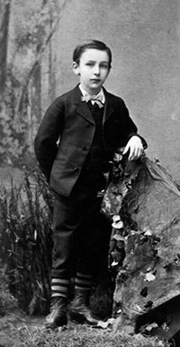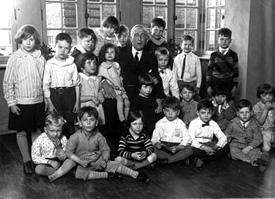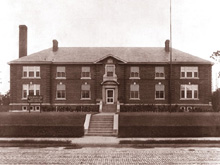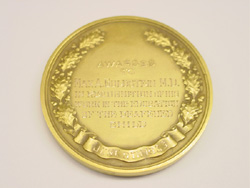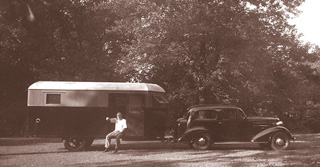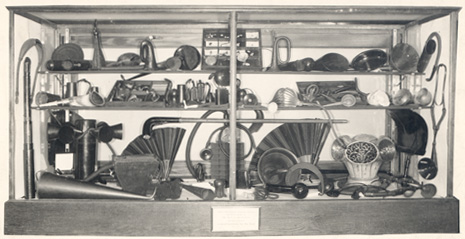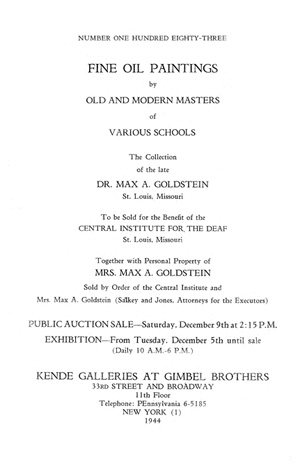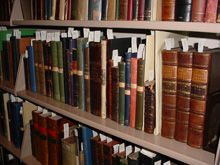 |
© CID – St. Louis |
Max A. Goldstein (1870-1941) and Central Institute for the Deaf
Max Aaron Goldstein was born in St. Louis, Missouri on April 19, 1870. His father, William, was a wholesale merchant who migrated to St. Louis from Northern Germany after the U.S. Civil War, and his mother, Hulda, was the daughter of a German rabbi who came to New York in the early 1860s. Dr. Goldstein was one of five children. He grew up in a rich cultural environment which led to a zealous interest in collecting stamps, coins, Indian relics, art objects and rare books.
Dr. Goldstein attended the St. Louis Public Schools, graduating from Central High School in 1887. He then entered the Missouri Medical College, graduating in 1892 at the age of only 22. After an internship at St. Louis City Hospital, Dr. Goldstein spent two years in post-graduate work in Europe. His interest in diseases of the ear, nose, and throat led him to the internationally renowned Vienna Polyclinic in 1893 to study with Dr. Adam Politzer, the developer of modern otology. While there, Dr. Goldstein became interested in the work of Professor Victor Urbantschitsch’s methods of improving the education of congenitally deaf children with apparent remnants of hearing by concentrating on stimulation of what he termed a dormant auditory sense.
Although Urbantschitsch’s method was met by skepticism and opposition by physicians and educators of the deaf, Dr. Goldstein was enthusiastic and determined to introduce these methods in the United States. Here began his determination and dream to convince the world that congenitally deaf children could learn to talk intelligibly.
Dr. Goldstein returned to St. Louis in 1895 to establish his medical practice. Within a year, Goldstein had been appointed chair of Otology at Beaumont Medical College and had founded a new medical journal, The Laryngoscope. He would serve as editor of the journal from it first issue in July 1896 until his death in July 1941. At the St. Joseph’s Institute for the Deaf, Goldstein started teaching a class of sixteen girls. He instructed the teachers on how to provide acoustic stimulation. Each pupil was to receive fifteen minutes of instruction daily and Dr. Goldstein supervised the teaching two afternoons a week.
During the ensuing years, Dr. Goldstein came to believe that deaf children should be regarded not only as clinical entities, but as individuals whose education and social and economic needs demanded professional and community attention. He also realized that otologists and the medical profession in general were not familiar with the problems of the deaf. While studying teaching methods in special schools, he found that only a small percentage of those teaching deaf children were adequate.
These observations led to the idea of establishing an institute for the deaf in which an effective cooperation between teachers, otologists, and other specialties would develop. In such an institute, teachers would be professionally prepared to educate deaf children and unbiased trials of various methods of teaching could take place. In 1914 Goldstein realized his vision with the establishment of Central Institute for the Deaf (CID). The first class consisted of four children and the school was located in rooms located above Dr. Goldstein’s medical offices. Within two years construction began on a new separate school building; by the time of Goldstein’s death CID had established an international reputation, with an enrollment of 300 students from all over the U.S. and several foreign countries.
Through the work of Dr. Goldstein and other luminaries, CID built an international reputation as a research and demonstration school and became known as the research home of the field of audiology. CID’s parent-infant program, begun in 1958, was the first program of its kind and a model for programs throughout the world. Over the years, basic and applied researchers at CID produced a wealth of knowledge, including important knowledge of the biology of hearing and deafness, clinical applications in audiology, and methods that have profoundly influenced the rehabilitation and education of deaf children worldwide.
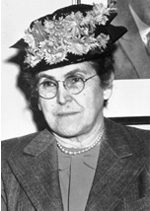 |
© CID – St. Louis |
| Leonore Weiner Goldstein |
|---|
Dr. Goldstein married Leonore Weiner in 1895. They became true partners in all of their endeavors. Mrs. Goldstein was an ardent CID supporter who assisted her husband in myriad ways and helped to raise countless funds. The Goldsteins were also lifelong patrons of the arts, showcasing the talents of young artists and musicians by hosting parties in their home. They founded the St. Louis Art League, which flourished from 1914 to 1924, and they both served on the St. Louis Symphony board, with Mrs. Goldstein taking over Dr. Goldstein’s membership from 1908 until her death in 1971 at the age of ninety-six.
“I am very interested, heart and soul, in the problems of the deaf.”
— Max A. Goldstein, 1917
| Dr. Goldstein’s Office at Vandeventer and Westminster Place | 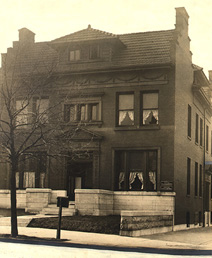 |
|---|---|
| Central Institute for the Deaf opened as a school on September 23, 1914 in rooms over Dr. Goldstein’s medical office at Vandeventer Avenue and Westminster Place. | |
© CID – St. Louis |
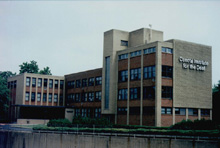 |
CID ca. 1955 |
|---|---|
| A state of the art clinic and research building was added to CID facilities. This building was completed in 1951. | |
© CID – St. Louis |
| CID 1999 | 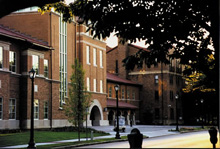 |
|---|---|
| The third CID school building, the first step towards an integrated new CID campus, was dedicated in 1999. | |
© CID – St. Louis |
“I’ve started things that I know I’ll never be able to finish. I know I shall not have enough time. And they are things that must be finished.”
— Max A. Goldstein, 1930
In 2001 CID completed a new campus, including a specially designed “quiet school” built for oral deaf education, an adult clinic and state-of-the-art biological research laboratories. In 2003, Washington University School of Medicine assumed ownership and governance of CID’s Harold W. Siebens Hearing Research Center, Spencer T. Olin Hearing Clinic, and graduate programs for audiologists, deaf educators and scientists (formerly the Washington University Department of Speech and Hearing, operated by CID). These programs now form the nucleus of a consortium of programs in hearing and deafness called CID at Washington University School of Medicine and operated by the Department of Otolaryngology-Head and Neck Surgery, one of the nation’s largest otolaryngology departments.
Effective with the 2003 agreement, the CID professional education programs assumed a new name, the Program in Audiology and Communication Sciences (PACS). Central Institute for the Deaf continues as a financially independent organization, closely affiliated with CID at Washington University School of Medicine.
Today, Central Institute for the Deaf and CID at Washington University School of Medicine continue a unique combination of education, research and clinical and community service, carrying forth Max Goldstein’s legacy of a place where teachers, doctors and parents work together to benefit deaf people, starting with children. Working audiologists, teachers and scientists serve as graduate program faculty and graduate students gain experience in real-world settings, including the CID Oral School, the Spencer T. Olin Hearing Clinic and the Harold W. Siebens Hearing Research Center on the CID campus. Work continues on the most progressive and promising techniques and technologies. CID schoolchildren benefit from state-of-the-art facilities and from a staff on the leading edge of knowledge in deaf education, audiology and rehabilitative techniques.
Dr. Goldstein was a Renaissance man of many visions whose legacies continue at CID and beyond. In addition to being a physician, he was a well-respected scientist, educator and scholar. He studied anatomy, physiology, neurology, genetics, phrenology, acoustics and biology in addition to deaf education. He wrote two books and founded, contributed to and edited some of the major academic journals of the day. He chaired the Otology Department at Beaumont Medical College (now St. Louis University School of Medicine).
| American Laryngological, Rhinological and Otological Society Medal Awarded Dr. Goldstein in 1933 | |
|---|---|
| Dr. Goldstein started the St. Louis League for the Hard of Hearing (now St. Louis Hearing and Speech Center). In 1933 he received the Gold Medal of the American Laryngological, Rhinological and Otological Society, the St. Louis Award, and an Honorary Doctor of Laws degree from Washington University. | |
© CID – St. Louis |
| Early Photo of the CID-Max A. Goldstein Collection |
|---|
| Dr. Goldstein was an avid collector of mechanical hearing devices, including the first models of commercially made devices. The CID-Goldstein Historic Devices for Hearing Collection at Washington University School of Medicine Bernard Becker Medical Library, contains more than 400 devices, the earliest dating from 1796. Dr. Goldstein’s intention was to bring a new perspective on the study of deafness by collecting such devices. |

